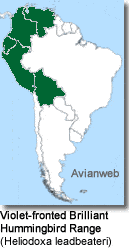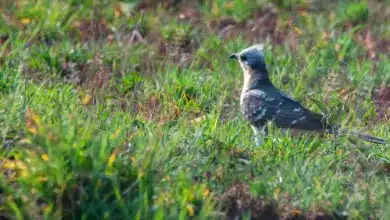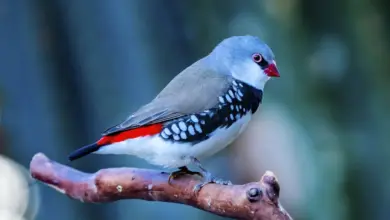Violet-fronted Brilliants – Hummingbirds
The Violet-fronted Brilliant Hummingbirds (Heliodoxa leadbeateri) – also known as Blue-fronted Flying Dolphins or Leadbeater’s Brilliants – are large South American hummingbirds.
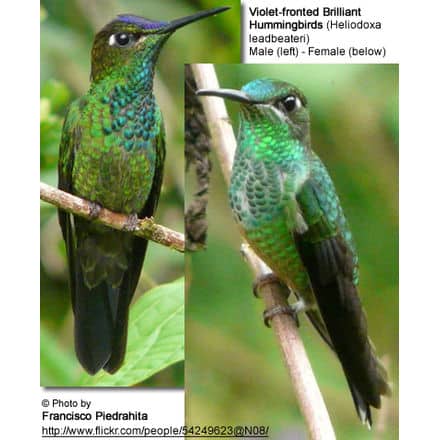
Distribution / Habitat
Their range stretches along the east slope of the Andes, from Venezuela, Colombia south through Ecuador and Peru to Bolivia.
They are fairly common and widespread in humid montane forests at elevations from 3,000 – 7,550 feet (~ 900 – 2,300 meters).
Subspecies, Ranges and ID
- Heliodoxa leadbeateri leadbeateri (Bourcier, 1843) – Nominate Race
- Range: Northern Venezuela in coastal mountains in Falcón, Yaracuy, Carabobo and Miranda.
- ID: The crown is glittering blue.
Heliodoxa leadbeateri otero (Tschudi, 1844)- Range: Central and Southern Peru and northwestern Bolivia.
- ID: The crown is glittering green
- Heliodoxa leadbeateri parvula (Berlepsch, 1887)
- Range: Northwestern Venezuela (Táchira, Mérida, Barinas, Trujillo) and northern, central and southern Colombia (Serranía de Perijá and eastern Andes south to the Macarena Mountains). Locally also found in the Magdalena and Cauca Valleys, and possibly also at the northern end of the central Andes).
- Heliodoxa leadbeateri sagitta (Reichenbach, 1854)
- Range: Eastern Ecuador and Northern Peru.
Description
Males average 5.5 inches (14 cm) in length, and the smaller female is about 4.25 inches (12 cm) long – including the tail. The bill measures about 1 inch (2.5 cm). The greenish or bluish tail is relatively long and notched. There is a short, but distinct white malar stripe (from the bill across the cheeks).
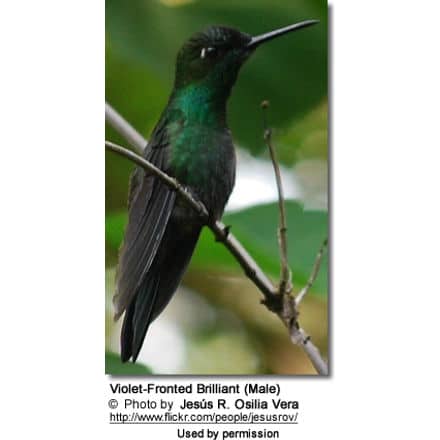
The male has a green plumage with a glossy green throat and chest. The crown is bluish / green (depending on subspecies).
The female is white below, heavily spotted with green. Her abdomen is usually buffy, flecked with green.
The juvenile has rufous cheeks and the upper throat may be rufous as well.
Hummingbird Resources
- Hummingbird Information
- Hummingbird Amazing Facts
- Attracting Hummingbirds to Your Garden
- Hummingbird Species
- Feeding Hummingbirds
Diet / Feeding
The Violet-fronted Brilliants primarily feed on nectar taken from a variety of brightly colored, scented small flowers of trees, herbs, shrubs and epiphytes. They favor flowers with the highest sugar content (often red-colored and tubular-shaped) and seek out, and aggressively protect, those areas containing flowers with high energy nectar.They use their long, extendible, straw-like tongues to retrieve the nectar while hovering with their tails cocked upward as they are licking at the nectar up to 13 times per second. Sometimes they may be seen hanging on the flower while feeding.
Many native and cultivated plants on whose flowers these birds feed heavily rely on them for pollination. The mostly tubular-shaped flowers actually exclude most bees and butterflies from feeding on them and, subsequently, from pollinating the plants.
They may also visit local hummingbird feeders for some sugar water, or drink out of bird baths or water fountains where they will either hover and sip water as it runs over the edge; or they will perch on the edge and drink – like all the other birds; however, they only remain still for a short moment.
They also take some small spiders and insects – important sources of protein particularly needed during the breeding season to ensure the proper development of their young. Insects are often caught in flight (hawking); snatched off leaves or branches, or are taken from spider webs. A nesting female can capture up to 2,000 insects a day.
Males establish feeding territories, where they aggressively chase away other males as well as large insects – such as bumblebees and hawk moths – that want to feed in their territory. They use aerial flights and intimidating displays to defend their territories.
Breeding / Nesting
Hummingbirds are solitary in all aspects of life other than breeding; and the male’s only involvement in the reproductive process is the actual mating with the female. They neither live nor migrate in flocks; and there is no pair bond for this species. Males court females by flying in a u-shaped pattern in front of them. He will separate from the female immediately after copulation. One male may mate with several females. In all likelihood, the female will also mate with several males. The males do not participate in choosing the nest location, building the nest or raising the chicks.
The female Violet-fronted Brilliant is responsible for building the cup-shaped nest out of plant fibers woven together and green moss on the outside for camouflage in a protected location in a shrub, bush or tree. She lines the nest with soft plant fibers, animal hair and feather down, and strengthens the structure with spider webbing and other sticky material, giving it an elastic quality to allow it to stretch to double its size as the chicks grow and need more room. The nest is typically found on a low, skinny horizontal branch.
The average clutch consists of two white eggs, which she incubates alone, while the male defends his territory and the flowers he feeds on. The young are born blind, immobile and without any down.
The female alone protects and feeds the chicks with regurgitated food (mostly partially-digested insects since nectar is an insufficient source of protein for the growing chicks). The female pushes the food down the chicks’ throats with her long bill directly into their stomachs.
As is the case with other hummingbird species, the chicks are brooded only the first week or two, and left alone even on cooler nights after about 12 days – probably due to the small nest size. The chicks leave the nest when they are about 20 days old.
Calls / Vocalizations / Sounds
Their songs are described as a series of sweet “tchew” notes; and their calls as a squaky, descending chatter: “dee-dih-doo.”
Alternate (Global) Names
Chinese: ????? … Czech: Kolibrík briliantový, kolib?ík fialovo?elý … Danish: Violetpandet Brillant … Dutch: Violetborstbriljantkolibrie, Violetborst-briljantkolibrie … Finnish: Violettisäihkykolibri … French: Brillant à front violet, Brillant de Leadbeater … German: Violettstirnbrillant, Violettstirn-Brillant, Violettstirn-Brilliantkolibri … Italian: Brillante fronteviola, Colibrì diamante di Leadbeater … Japanese: sumirebitaiterihachidori … Norwegian: Blåpannebriljant … Polish: brylancik modroczelny … Russian: ?????????????? ????????? … Slovak: briliantovec modrocelý, briliantovec modro?elý … Spanish: Brillante Frentivioleta, Colibrí de Frente Azul, Diamante Coronado … Swedish: Violettpannad briljant

